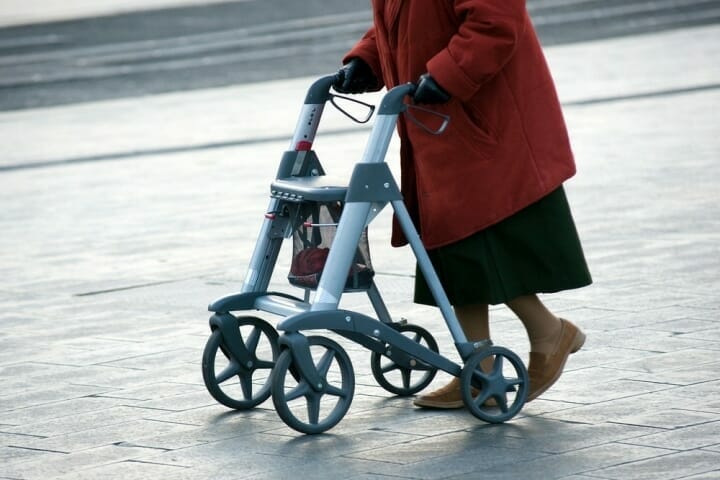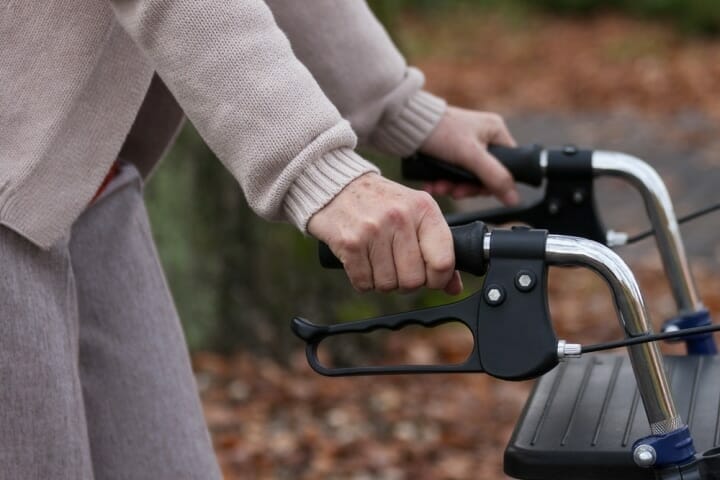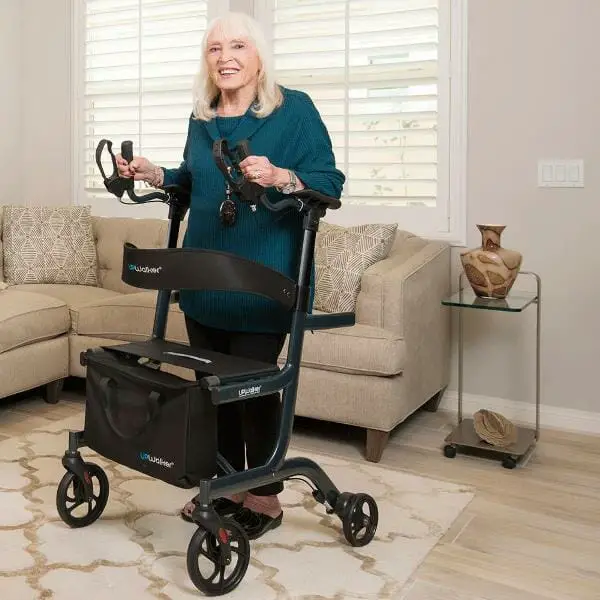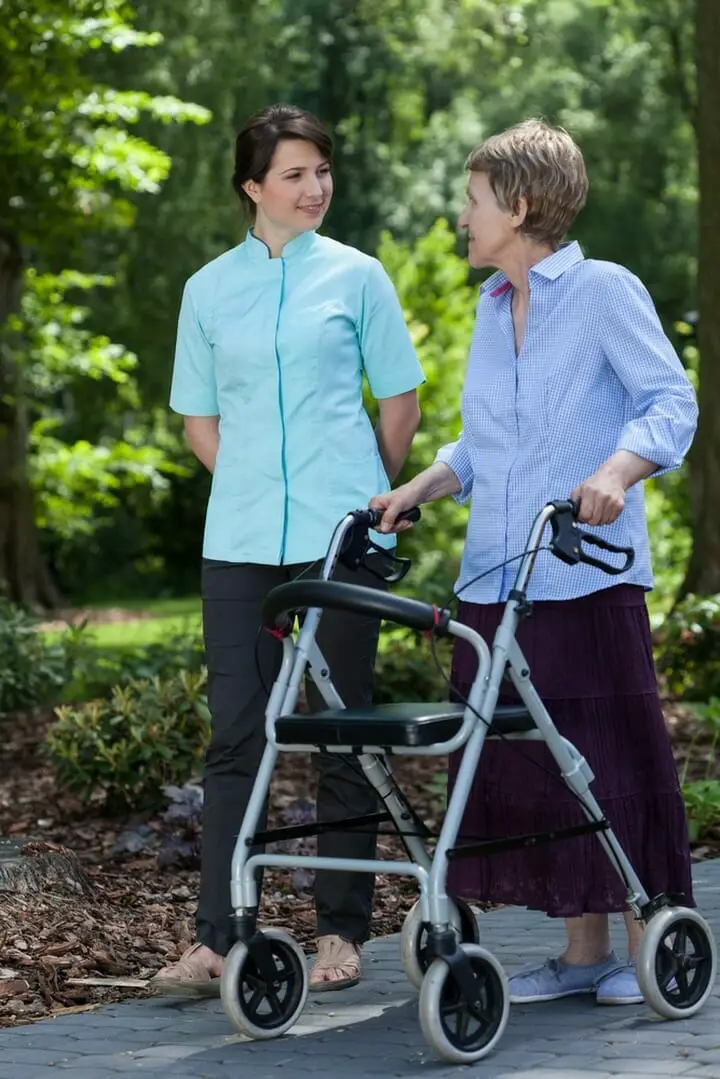As our parents or loved ones grow old, their muscles weaken, and their stamina decreases, which often causes them difficulties in maintaining balance and stability while walking or standing. Usually, they resort to the help of medical aid devices to move around comfortably.
In the year 2011, almost 24% of Americans aged 65 years and above were using some sort of mobility device, and since then the number has increased continuously[1]
Seniors find it difficult to walk due to arthritis pain, decreased strength, and other aging factors. Mobility aid devices such as walking canes, mobility scooters, wheelchairs are the most common equipment for moving around. But these days rollators or rolling walkers are becoming perhaps the most popular amongst mobility aids.
However, it is also important to know how to use the rolling walker properly, without which you may invite grave injuries. Hence, for your safety and security, it is important to learn how to use a rolling walker properly. Let’s take a deep dive and understand the entire concept thoroughly.
Contents
What Is A Rolling Walker?
A rolling walker is often also called or known as a rollator. It is a unique mobility aid device with four legs with wheels attached to it. These devices are equipped with brakes for users who need minor assistance in stopping themselves and the rollator.
These rolling walkers are ideal for the elderly who have limited strength in their arms and have difficulty lifting and operating a standard walker. The rollator walker’s rolling motion makes the task of using the walker very smooth, and it also requires significantly less effort to use.
It usually has a compact and foldable frame connected to three or four wheels, with additional handlebars for holding along with a seat for temporary sitting and resting.
How Do You Properly Use A Rolling Walker?
Many elders who use a rolling walker initially face a significant problem: they are not aware of the proper method or way to use a rolling walker properly.
Firstly they must ensure that the walker is set at the correct height according to them, then they must stand close to the walker with their hands on the handles and feet just behind the rear wheels. Once they feel steady, they can then disengage the brakes and then start walking.
There are four significant actions which they need to perform to use the walker properly.
Walking With The Walker
It is the most important and primary action performed using a rollator, which can be very easy for some users to adapt to while some may take some time to get used to it.
The basic process involves placing the walker in the front, then grabbing onto the handles loosely. The next step is to ensure you are stable and balanced before you start walking. After that, start walking by keeping most of the weight on the legs while using the walker’s hands for support. Then use the brakes to maintain control over its speed.
Turning With A Walker
Turning and twisting with a rolling walker is as simple as moving forward with it.
If a user is comfortable in moving forward, then he/she can easily learn how to turn them. If the user is standing still and wants to move in another direction, they can keep the rollator in front of their chest and then take small steps in the direction they want to turn to, and the walker will naturally follow the user’s movement.
You can get a much tighter turning radius by applying the rollator’s brakes from one side and then turning. The patient or the user must also take care of turning quickly or sharply may disbalance the walker.
Sitting On A Rollator
You can get yourself a rollator walker with a seat if you would like to rest in between your walk. But remember, sitting on some rollators can be tricky, especially if you are not as mobile as you used to be.
The safest option to sit on a rollator walker is to lock the brakes before sitting down. It is also recommended that you also push back the walker against a wall to get more stability. Then you must gently sit down by bending the knees and using their legs to lower yourself in a slow and controlled manner.
Standing Up From The Rollator
Standing up from a seated position on the walker is the reverse of the sitting process.
Firstly the patient or the user must check whether the brakes are still on or not. After ensuring this they must sit closer to the edge of the seat with their feet placed closer to the body so that they have a solid base to stand on.
The user can easily get up without any risk of tumbling if they religiously follow these instructions.
You may also like Does Medicare Pay For Upright Walker
When Should You Not Use A Rollator?
The rolling walkers have many advantages, but there are some scenarios where the patient must not use a rollator. Some of the cases are mentioned below.
Users with very low stability and balance
As the rolling walkers have wheels, they do not hold steady as walkers without wheels.
Even after the full application of brakes, there is a small chance that you might not be able to stop the walker completely. In such a case, the patient must have some amount of control and balance.
The sudden application of brakes can also lead to sudden jerks, resulting in the patient falling. Hence, if you lack in stability and body-balance avoid using a rollator.
Users with low abdominal strength
Ideally, the users need to have a decent abdominal strength to react to the rotation and the rollator’s turning movement. The users need to pivot quickly when using a rollator walker, or else there is a very high chance that they might fall and hurt themselves.
Users with weak legs
Users who have weak legs or feet due to injury or disability must use a wheelchair as a mobility aid device. A wheelchair would allow them to rest their legs and move around quickly as well as independently.
Now, if you have learned how to use a rolling walker properly, you can go ahead and learn about the different types of rolling walkers available in the market and how they are different from one another.
You may also like Where Can I Buy An Upright Walker?
What Are The Different Types Of Rolling Walkers?
There are many different types of rolling walkers available in the market with unique features that cater to or fulfill a particular need. Most of these unique features are related to the patient’s physical conditions, such as height, weight, build, strength, etc. Some of the significant types of rolling walkers are discussed below.
Height Adjustable Rollator Walker
As the name suggests, the main feature of these types of rolling walker is adjustable height. Due to this adjustable height feature, these walkers are suitable for those with their height ranging from 5 feet to 6 feet.
Using a correct height rollator is extremely important as if the walker’s height is too low, then the users tend to hunch down while holding the walker. This would damage the neck and the back, encouraging the wrong posture.
Similarly, if the walker’s height is too high, then the patient would not be able to hold the walker properly, disorienting the patient and causing them discomfort.
A height-adjustable rollator walker has handlebars whose height can be changed easily. They mostly come with a seat for providing more convenience to the user.
Bariatric Rollator Walkers
A bariatric rollator walker is a specially designed walker for those who are overweight or have undergone bariatric surgery and need a walker, which can support more weight than the traditional walkers.
A standard rollator walker supports anywhere from 250 to 350 pounds of weight, whereas the bariatric rollators have a load capacity between 350 and 500 pounds.
Usually, these walkers have low seats, which increases the center of gravity for the walker providing it with more stability and balance. These walkers also have additional features such as a reliable and sturdy frame, which can easily lift heavy weights.
You may also like Can You Rent An Upright Walker?
Lightweight Rollator Walkers
A lightweight rollator walker is suitable for those who are too frail or weak to use a traditional rollator walker. The conventional rollator walker’s weight ranges from anywhere between 17 to 30 pounds, whereas the lightweight rollators have their weight in between 10 to 15 pounds.
Users who lack the strength to lift and fold up the standard walkers find these very useful, although these rollators are less sturdy than the traditional models. These models are less stable and carry the risk of tipping over.
Upright Walkers
As their name suggests an upright walker helps you stand erect while walking. It has higher armrests where you can place your forearm to keep your back straight while walking.
Up Walker Lite Posture Walker Mobility Aid
Three-Wheel Rollator Walkers
The Three-Wheel rollators have a special design as these walkers have three legs instead of four legs. These walkers look like small tricycles, and they are effortless to maneuver as they can make better turns and easily fit through tight spaces.
Most three wheel rollators are easy to fold and store. Although these walkers are less stable than the four-wheel walkers and they mostly do not have a built-in seat, so they are not advised for someone who requires to sit while walking.
You may also like How Safe Are Upright Walkers?
Features Of An Ideal Rollator Walker
Foldability
The best rollator walkers must be foldable so that the process of storing the walker when it is not in use is simplified. The best rolling walkers fold onto their wheels in a standing-up position and can be easily placed against a wall. The walker’s design takes up less space due to which it can easily store in tight spaces. The rollators must also have a clip so that they remain folded.
Ideal width
The rollator walker must also have a perfect width, narrow enough to pass through narrow doorways and pathways easily. Ideally, their width should not be more than 25 inches. There are narrow rollator walkers available in the market to help this problem, which are less wide but sturdy enough to function as a rollator walker properly.
Indoor Or Outdoor Usage
Some rollators usually have large and wide wheels (casters) specially designed to work outdoors. These wheels generally also have superior protection, which protects the floor or tiles from sustaining damage.
The wheels’ ideal size should be around 6 inches, whereas bigger wheels with 8 and 10 inches size provide extra stability, making the rollator less prone to tipping over and falling.
Some of the walkers have larger wheels on the front compared to the back, which moves the center of the gravity at the back, making the device more stable and reducing the chances of slipping or tipping.
These rollator walkers are suitable for rough surfaces because of their large and wide wheels. These wheels also have an anti-slip design, which maintains a firm grip on the surface, enhancing the walker’s stability.
Seat
Ideally, the seat of a rolling walker should have a broad and deep design to provide comfortable seating, even if it is for a short time. Most seniors require and use the seat to rest and regain their stamina, which is impossible if the seat is not wide or comfortable enough.
To maximize the user’s comfort, the seat has extra foam padding with an extra padded backrest. A backrest plays an essential role in maintaining the correct posture and provides the right support to the spine. The rollator walkers with seats are ideal for frail and weak elderly.
External And Internal Brakes
Generally, there are rollators with two types of brake wire orientation: the external brake wires and the other is the internally embedded brake wires. Internal brake wires are very functional as they are not visible. Visible cables can easily get entangled in nearby objects, causing the rollator to tip and fall.
Rolling Walkers Accessories
Rollator walkers can have a lot of accessories and features that greatly enhance the users’ experience. Some of these features are trays and baskets, cane and/or umbrella holders, plush seats, cup holders, utility storage bags, personal pouches, etc.
Storage space is especially important for those who use rollator walkers regularly or who need to carry equipment such as oxygen tanks along with them. Rollator walkers with storage bags are also suitable for carrying grocery or personal items.
The cane or umbrella holder is can be a handy accessory, especially for outdoor settings where the user has to protect themselves from rain or sun.
You may also like Upright Walker vs Rollator
Conclusion
A rollator walker can make your life a lot simpler but before using it get well-versed with its features and learn how to use it properly to avoid any mishaps. Now that you know how to use a rollator walker properly and the different options out there, we hope that you can use this information comes handy in your decision-making process. Good luck!
References:





